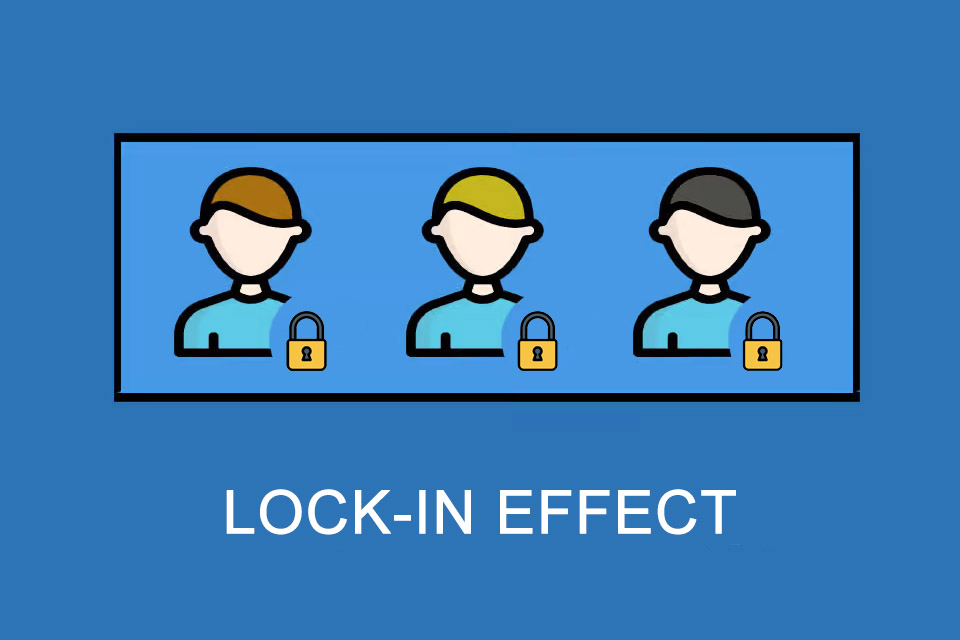What is the Lock-in Effect?
Table of Contents: Definition – Switching Costs – Examples – Questions from the field – Notes
Lock-in effect – retaining customers for a long time with strategy
Many companies want to retain customers for their products or services in the long term. One way of achieving this is the so-called lock-in effect. It describes the difficulty customers have in switching from one product, product family or service of a company to possible alternatives from other providers. Customers become technically, functionally or economically dependent to such an extent that a possible switch is associated with high effort and/or costs.
John D. Rockefeller¹ is considered the inventor of the lock-in effect. In the 1870s, he utilised the interdependence of products when he sold paraffin lamps in China. As he had a monopoly on paraffin, the lamps could only burn with his paraffin. This enabled him to increase sales of both products.
The switching costs of the lock-in effect
Switching costs are a key lever in the lock-in effect. Switching costs refer to the costs and inconveniences that arise when customers or organisations decide to switch from one provider, product or service to another. These costs can be financial, temporal, organisational or emotional and can take various forms. Examples of switching costs are
- Direct financial expenses associated with switching, such as the purchase of new equipment or software, membership fees or contractual penalties.
- Customers or organisations have to invest time to familiarise themselves with a new provider, negotiate contracts, migrate data or familiarise themselves with new systems.
- A change can also have organisational implications, such as training employees on new processes or systems, adapting internal processes or coordinating with other departments or partners.
- Customers may have already invested in using a particular provider, be it in the form of training, customisation or the purchase of accessories.
- Customers may also be reluctant to switch for emotional reasons, especially if they have a strong attachment to a particular vendor or product, or concerns about the risk of switching.
In short, switching costs play an important role in the decision of customers or organisations whether to stay with their current provider or switch to another. The higher the switching costs, the more likely it is that customers or organisations will stay with their current provider, even if better alternatives may be available.
Examples of the lock-in effect
There are a number of concrete examples of how companies use the lock-in effect for strong customer retention:
- Gilette customers not only buy the razor, but also regularly buy new blades that are specially made for the razor. As the blades are not compatible with razors from other brands, customers become loyal to the brand.
- Apple has built a broad ecosystem of products and services, including iPhones, iPads, MacBooks, Apple Watch and more. Customers who choose these products benefit from seamless integration and synchronisation between devices as well as exclusive services such as iCloud. This strongly ties them to the Apple ecosystem.
- Customers who sign up for Amazon Prime receive a variety of benefits such as free shipping, access to streaming services, exclusive offers and more. These benefits encourage customers to shop with Amazon more frequently and become loyal to the platform.
- Microsoft Office is one of the leading productivity suites on the market. Many organisations and individuals use Office applications such as Word, Excel and PowerPoint for their daily tasks. Because Office files are often stored in Microsoft’s proprietary format, customers become locked into the suite.
- Car battery manufacturers often offer free installation or discounts with the purchase of a new battery. Customers who have bought a particular brand once and benefited from the installation services tend to stick with the same brand the next time they change their battery.
- Companies such as Nespresso have introduced coffee capsule systems where customers have to buy special coffee capsules that are only compatible with their machines. This ties customers to the brand and the capsule system.
- Car owners are often tied to branded garages in order to obtain warranties or use special parts. This creates a certain dependency on the brand and the dealer network.
- Customers who take out long-term insurance contracts may be faced with cancellation fees or the loss of built-up capital. This may discourage them from switching to another insurance provider.
- Customers who choose a particular e-book reader are often tied to the associated e-book platform. This means that they cannot simply read their purchased books on another device, which increases the lock-in effect.
- Customers who opt for a long-term contract with a gym may be prevented from switching to another gym by high cancellation fees or penalties, even if it may offer better facilities or prices.
- Customers who are part of a particular airline’s frequent flyer programme are often tied to flying frequently with that airline in order to take advantage of the programme’s benefits, reinforcing the lock-in effect.
- Social media users often have a strong attachment to a particular platform due to their social networks, saved content and personal connections. This makes it difficult to switch to another platform, even if there are privacy concerns or other issues.
This list can easily be extended with real-life examples.
Questions from the field
Here you will find some questions and answers from the field:
What advantages does the lock-in effect offer customers?
- Customers can benefit from continuity and familiarity if they feel tied to a particular provider, product or service. They know the product or service, know what to expect and may feel more confident in their decision.
- The lock-in effect simplifies decision-making, as customers do not have to constantly compare and switch between different providers or products. If a customer is happy with a particular provider, they can focus on maintaining that relationship rather than spending time and resources looking for alternatives.
- In some cases, providers reward their long-standing customers with special perks, loyalty rewards or additional benefits to recognise their loyalty. Customers can benefit from these additional perks by staying with a particular provider for the long term.
- The lock-in effect can also offer customers a sense of security, as they have less to worry about having to constantly deal with new products or services. They can rest assured that their choice is stable and reliable, which can reduce their uncertainty and anxiety.
However, it is important to note that the lock-in effect can also have disadvantages, such as limited choice, higher prices or being stuck with outdated products or services. Customers should therefore weigh up their options carefully and consider the long-term implications of being locked into a particular provider.
Why do many companies fail to retain customers through the lock-in effect?
The lock-in effect can be an effective customer retention strategy for some companies. However, there are various reasons why other companies may not be able to successfully utilise this effect.
One reason may be a lack of product quality or customer experience. Customer retention is often based on customers being satisfied with the product or service. If a company is not able to offer high-quality products or ensure a positive customer experience, customers will not be motivated to remain loyal to the brand in the long term.
Another reason is competition and the variety of alternatives customers have in some industries. Even if a company tries to capitalise on the lock-in effect, customers can easily switch to another provider that may offer better offers or services.
Transparency and trust also play an important role. Customers today have access to information, reviews and comparison options on the internet. If a company tries to achieve the lock-in effect through opaque or dodgy practices, this can undermine customer trust and cause them to avoid the brand.
In industries characterised by rapid technological change, it can also be difficult to leverage the effect. Customer preferences and the technological landscape are changing rapidly. A product or service that is popular today could be obsolete tomorrow.
High switching costs can favour this, but they can also deter customers early on and make them look for alternative providers. If switching costs are too high, customers may remain dissatisfied, even if they are loyal to the company.
Finally, a company’s reputation can be negatively affected if customers feel that their freedom of choice is being curtailed or satisfaction is being exploited. Customers may turn away from the brand and publicly criticise it, which could cause long-term damage.
Overall, success in capitalising on the lock-in effect depends on various factors, including the quality of products and services, the competitive situation, customer trust and the transparency of the company. Companies should develop a balanced strategy that promotes customer retention without annoying or overwhelming their customers.
When is the use of the lock-in effect unlawful?
- Companies have been prosecuted when they took advantage of their dominant position to lock customers into their products or services and hinder competition. A well-known example is the case against Microsoft in the 1990s over allegations of abuse of its market power in connection with the Windows operating system and Internet Explorer.
- Courts can declare agreements between companies illegal if they restrict competition or hinder access to markets. For example, exclusivity agreements between a supplier and a distributor could be investigated if they restrict competition.
- If a company attempts to control the price of its products or services and prevents distributors from offering lower prices, this may be considered a breach of competition law. Price cartels or vertical price fixing are considered illegal by many courts.
- Companies have been investigated if they have made it difficult for customers to access their own data in order to make it more difficult to switch to another provider. This can be particularly relevant in areas such as social media or cloud services.
- Courts have declared some contractual clauses illegal that impose high penalties or fees on customers if they want to switch to another provider. Such clauses can prevent customers from benefiting from better offers and impair competition.
These examples show that there are different types of practices that are or can be illegal if they hinder competition or harm consumers’ interests. Companies should inform themselves about the applicable competition law provisions and ensure that their business practices comply with the legal requirements.
What is the connection between the lock-in effect and the hold-up problem?
The lock-in effect and the hold-up problem are two concepts that refer to similar effects but occur in different contexts and have different causes.
The lock-in effect occurs when customers or companies find it difficult to switch to another provider, product or technology due to previous decisions or investments, even when there may be better alternatives.
Typical causes of the lock-in effect are high switching costs, lock-in to proprietary systems or standards, loss of investment or habits.
The hold-up problem occurs when one party takes advantage of its negotiating position after the conclusion of a business contract to demand unfavourable conditions for the other party. Typical causes of the problem are asymmetric information, incomplete contracts or investments made by one party to strengthen the negotiating power of the other party.
Example:
Suppose a company A needs specialised software for its business processes and decides to use software from supplier X. After some time, the company invests in training for its employees and customisation of the software, which increases the switching costs. Here we see the lock-in effect: the company is now tied to provider X and finds it difficult to switch to another provider, even if there may be better alternatives.
If provider X suddenly raises its prices or reduces the quality of its service, company A is forced to accept the new conditions as it has no alternative due to its investment and dependence on provider X’s software. Here we see the hold-up problem: Provider X exploits its position to demand unfavourable conditions for Company A.
Conclusion: The lock-in effect is due to the difficulties in switching to another supplier, the hold-up problem refers to the exploitation of bargaining power after the conclusion of a business contract; two similar concepts that occur in different contexts and have different causes.
Impulse to discuss:
At what point should companies consider whether they should actively think about the lock-in effect?
Notes:
[1] Information on John D. Rockefeller
If you like the article or would like to discuss it, please feel free to share it in your network. And if you have any comments, please do not hesitate to send us a message.
Lock-in effects also exist in tax law, for example in the international taxation of capital gains.
And here you can find additional information from the t2informatik Blog:



